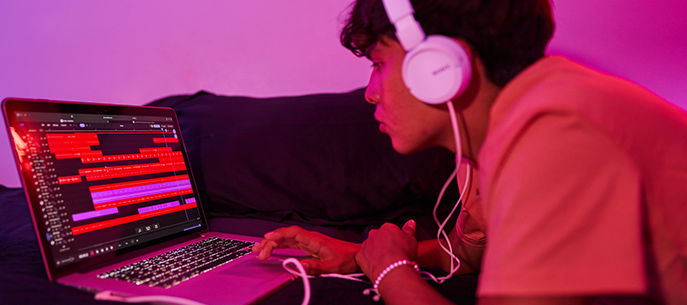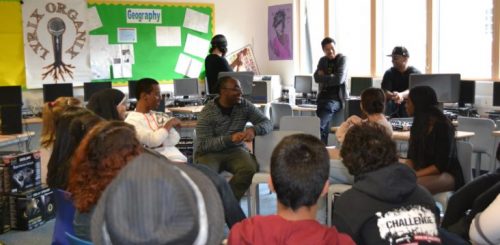
How to Make Music with a DAW
July 28, 2023Are you ready to dive into the world of creativity and make music like never before? Get ready to unleash your musical genius with easy-to-use audio production software.
Making music with a DAW is easier than ever before. Gone are the days of needing expensive studios and a plethora of gear – now, all you need is an internet connection, your favorite DAW, and your imagination. Whether you’re an aspiring producer, a seasoned musician, or an educator bringing music to your classroom, a DAW opens up a world of possibilities for your musical creations.
But don’t worry if you’re new to all of this – we’ve got you covered. Today, we’ll walk you through the basics of using a DAW, setting up your virtual studio, navigating the interface, and bringing your musical ideas to life.
Understanding the Basics of a DAW
Before you jump in and start creating, you’ll need to know the fundamentals of DAWs and how they work. Pretty soon, you’ll be ready to start recording music.
What is a DAW?
A “Digital Audio Workstation,” also known as a DAW, is your virtual studio where you can easily record, edit, and arrange audio tracks. It’s the ultimate playground for music makers and storytellers ready to bring their creative ideas to life!
Although most people use DAWs to make music, you can also create podcasts or use the power of sound to enliven your curriculum. Now, let’s review a few tips to help you choose the best DAW to create your musical masterpiece!
How to Choose the Right DAW for Your Needs
There are many different DAWs to choose from, but some are better than others. If you’re new to the world of music production, then you’ll want to select a DAW that is intuitive and easy to use. Also, the best DAWs will allow you to access EQs, compressors, and plenty of cool sound effects that help you create professional, polished sound.
If you’re not sure where to start, Soundtrap for Education comes with all the features you need to unleash your creativity! You can hop in the Soundtrap Studio and experiment with sound whether you’re using a Mac or PC. And since Soundtrap stores all your hard work in the cloud, there’s no need to overload your storage with tons of audio files.
The best part is we have a library of tutorials that you can use to learn more about recording, mixing, and mastering your music.
How to Make Music with a DAW
Are you ready to make music with your DAW? We’ll let you know everything you need to start creating and developing your own music production process. If you’re a little intimidated, know that you can perfect your musical process as you go and learn along the way. Let’s get started!
1. Find Video Tutorials for Your Chosen DAW
Every well-known DAW will have YouTube channels that you can use to find in-depth information about any aspect of your music-making software. Before you jump in and start recording, have fun exploring the DAWs interface, so you know how to record and edit your song when it’s time to lay down some tracks!
Just make sure you don’t overwhelm yourself with too much information. Remember, learning how to make music is a lifelong process, so you’ll be able to learn along the way. For now, just take the time to grasp the basics of music production.
2. Create Lyrics and Structure Your Song
It’s time to make music! You can get started by creating lyrics that convey your message or emotions. Many music makers begin with the lyrics, but you can always start with a catchy beat or an instrumental track if it’s better for your creative process. Try playing a few backing tracks or a few of your favorite songs for inspiration and begin writing from there. Pretty soon, the lyrics will begin to flow.
Once you have lyrics and a compelling melody, break your song down into five parts: the intro, verses, chorus, bridge, and outro. Although it’s not necessary to follow the standard song structure, this will ease the process when you’re recording your first song.
3. Lay Down a Few Tracks
In music production, tracking is the process of recording each one of the instruments that you’ll use to create your song. For most songs, you’ll have several different tracks, including the vocals, drums, and any other instruments that you use. If you don’t have access to traditional musical instruments, you can always use the virtual instruments available in your DAW.
If you’re going to make music with Soundtrap, you can upload your audio files or record the tracks yourself. When you’re finished recording, arrange your tracks in the order that works best for you. Thanks to Soundtrap’s Auto-Save feature, you can take a break anytime without missing a beat!
4. Add in Some Audio Effects
Is your song missing something? Add a little pizzazz with a few audio effects! The best DAWs come with a wide range of groovy audio effects that you can use to take your sound to the next level. Audio effects are a great way to add dimension and excitement to your song.
Depending on your song, you may want to experiment with reverb, delay, distortion, or compression. If you don’t see an audio effect you would like to use, you can always download audio effect plugins for the perfect finishing touch to your song.
5. Mix Your Song
Now comes the fun part: mixing! It’s all about finding the perfect balance between your audio elements. Dive into EQ, compression, panning, and other essential mixing techniques to craft a harmonious and sonically-rich sound. During mixing, your song will begin to sound like something you might listen to on your favorite streaming service.
Mixing can become quite complex, but most music makers follow these steps:
- Balance the EQ. Use EQ to sculpt each track’s frequency balance, removing unwanted frequencies and enhancing desired ones.
- Add compression. Apply compression to control dynamics and add depth and punch to individual tracks or groups.
- Create dimension. Utilize reverb and delay to create space and add dimension to your mix
- Pan the instruments. Pan instruments across the stereo field to create width and separation.
- Balance the levels. By balancing the levels of each track, you can ensure that one sound doesn’t overpower the others.
And there you have it! Now, you can take your mix and add a little automation for a dynamic sound. With dedication, practice, and experimentation, you’ll be mixing like a pro in no time!
6. Master Your Mix
The finishing touch to any musical creation is mastering. Mixing and mastering might seem the same to the untrained ear, but they’re quite different. In the simplest terms, mixing is when you make sure that your song sounds balanced, but mastering is when you add the finishing touches to your track to be ready for streaming services. Once your mix is up to par, you shouldn’t need to do much during mastering.
You can master your mix with these simple steps:
- Listen to a reference track. A reference track is a song released by another artist that sounds similar to yours. By listening to the reference track, you’ll know how much you need to adjust the song’s volume so that it sounds the same as other songs in your genre.
- Apply EQ and Compression. You should have already balanced the EQ and added compression, but if you need to make any minor adjustments, now is the time to do it.
- Apply Limiting. Whatever you do, don’t skip this step! Limiting will bring your song’s volume to commercial levels to be ready for distribution.
After all your hard work, your song is finally ready to share with the world. Learning how to make music with a DAW takes time, but there’s nothing you can’t do if you put your mind to it.
Make Music with Soundtrap for Education
Soundtrap for Education is the ultimate audio production platform for students and teachers to create and edit audio recordings. Pupils and educators can easily tap into their artistic side with this intuitive audio platform that facilitates a creative learning environment for every subject, regardless of the student’s age or experience level.
With Soundtrap for Education, students and teachers can collaborate with advanced cloud technology at any time or place. In addition, the platform comes equipped with a robust resource portal, with tutorials, an external curriculum, and lesson plans to complete the educational experience. And to ensure privacy, teachers can keep student collaboration safe and secure with invite-only groups in Soundtrap’s versatile digital environment.
If you’re ready to enhance your educational experience with an intuitive cloud-based audio production platform, start with Soundtrap for Education! And be sure to share this article with other teachers in your network to help spread the joy of learning through sound.
 EDU Portal
EDU Portal


